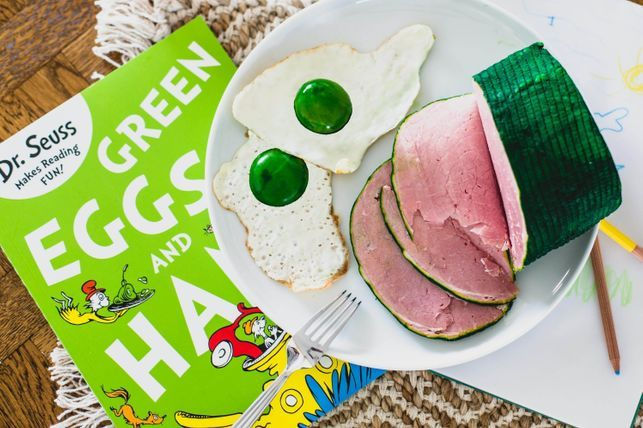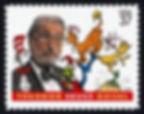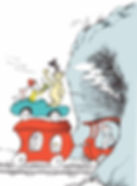
Consent and Green Eggs And Ham
[ad_1]
It’s a wildly imaginative, rhythmically appealing, slightly unnerving story set in a trademark wacky world – and it’s a children’s classic… Green Eggs And Ham came about on the back of a $50 bet that Theodor Geisel, aka Dr Seuss, couldn’t write a book using – as the publishers of the 1960 edition I read in my childhood proclaimed – “ONLY 50 DIFFERENT WORDS”*. He won the bet and, as the publishers maintained, “concocted a little masterpiece that we believe will delight beginning readers for generations to come”.
Too true! From the book’s entertaining, disconcerting, surreal storyline parents have drawn lessons on trying new things, not being judgmental – and even resilience and persistence.
But what if reading Green Eggs And Ham to your child in this day and age raises red flags for you around consent?
Here sex educator Rebecca Koon, founder of every.body talks, talks us through the book’s problematic message, how she frames it for her daughter and what her 3-year-old has taken away from it all…

In the picture: a 2004 US stamp honouring Dr Seuss
Dr Seuss has made me into a bedtime feminist killjoy. I groan inwardly every night as my toddler chooses her two bedtime stories, one of which is invariably Dr Seuss’s beloved 1960 classic Green Eggs And Ham.
I don’t groan at reading the same book for the thousandth time – parents of toddlers quickly become accustomed to narrative repetition. I groan because I know that reading this book requires me to engage my almost 3-year-old in a conversation about consent.
At bedtime.
When all I want to do is get her to sleep as soon as possible so I can eat the cake I’ve been hiding from her or have a conversation with another adult in which we both complete all of our sentences.
I know that talking to my daughter about consent is important, and I want to do it. I do. Just not at bedtime. That Dr Seuss, though, he forces the issue, just like Sam-I-am forces the character in Green Eggs And Ham to taste the eponymous dish.
What’s wrong with this picture?
In case it’s been awhile, here’s a recap: the first few pages feature Sam-I-am, a character with a yolk-yellow body, passing back and forth through a room. He’s clearly annoying the book’s other main character, a dog-like creature wearing a tall black hat and reading a newspaper. This hatted creature, after watching Sam pass by several times, throws down his paper and declares: “That Sam-I-am! That Sam-I-am! I do not like that Sam-I-am!”
Even before the food enters the picture, there’s already conflict between these two, which makes what happens next disquieting. Sam brings in a platter of very unappetising green ham with two fried eggs sporting bright-green yolks and thrusts it into Hat Guy’s face. Sam will spend the remainder of the book coercing Hat Guy into eating this mouldy fare. Hat Guy looks understandably disgusted.

“Eat them! Eat them! Here they are…” (Image: TM & © Dr Seuss Enterprises/Guardian)
Sam asks: “Do you like green eggs and ham?” Hat Guy answers: “I do not like them, Sam-I-am. I do not like green eggs and ham.”
At this point I have to stop reading and explain to my daughter that this really should be the end of the story. When Hat Guy tells Sam that he doesn’t like green eggs and ham, Sam should just say: “OK, see you later then” or “Can I get you something else? What would you like?”
Instead we get 49 more pages that send a very problematic message about consent.
Sam follows Hat Guy around asking him to try green eggs and ham in various locations, as if eating green ham with a mouse or a goat in a house or a boat would somehow make it more appealing. Hat Guy tries to walk away – which, I always mention, is a great strategy for dealing with someone who won’t stop pressuring you – his facial expressions and body language getting angrier with each attempt Sam makes, but Sam will not give up. Sam is so aggressively determined that he runs into Hat Guy with his car, forcing him onto the bonnet, where he holds on as Sam speeds up a tree and onto a moving train.
This is all presented in Dr Seuss’s characteristic bright and cheerful colours and delightfully satisfying rhythms and rhymes, but if you think about it it’s actually quite terrifying.

Tunnel vision (Image: TM & © Dr Seuss Enterprises/Guardian)
Pursued by an intractable bully and now physically unable to escape, Hat Guy is subjected to ever-more insistent requests to eat Sam’s eggs and ham, which he firmly and repeatedly refuses. His situation becomes more dire as the train runs off the tracks onto a boat, which sinks. Hat Guy, now trapped with Sam and the miraculously intact platter of green eggs and ham floating in the middle of the ocean, finally agrees to taste the food.
He does so with clear resignation. He’s not agreeing enthusiastically; he’s assenting reluctantly in order to get Sam to stop persecuting him. He’s not saying yes; he’s just been bullied into not saying no. It’s a survival strategy, not consent.
He lifts the fork to his mouth, making a disgusted face at the bright-green yolk he’s about to ingest. Sam looks on expectantly. And now the most troubling thing of all: Hat Guy likes it.
Teaching consent
You could, and most parents probably have, interpret this as a lesson in trying new and unfamiliar foods – a popular and necessary message in stories aimed at the under-5 set. Perhaps that’s all Dr Seuss intended. But I see, very clearly, a much more sinister message in this book.
It teaches children that no does not mean no – it means try harder and use any means necessary to get the answer you want. It teaches them that it pays to have no regard for other people and their feelings and desires.
Worst of all, it teaches children that people do not actually know what they want and don’t want, and that when forced to do something they will like it because the person with more power knows better than they do what they desire.
If you reread this book and mentally replace unwanted food with unwanted sexual attention, the problems become very clear.
This is what makes me feel like a killjoy. Can’t I just read and enjoy the story in the spirit it was intended? Does a beloved children’s book really have to turn into a feminist teachable moment?
Dr Seuss almost certainly did not have consent in mind when he wrote this book. His mid-century sensibility probably didn’t allow for the concept except in the most extreme circumstances (ie violent sexual assault). Parents and children have enjoyed this story for decades without my concerns.

Food for thought (Image: News.com.au)
But in a cultural moment in which it has become very clear that we have serious confusion about the meaning of consent, I can’t see anything else when I read this deeply troubling book. But my daughter loves it, so I keep reading it, we keep having the same conversation about consent and I keep hoping my message is overriding the one Dr Seuss delivers.
I want her to know that when she says no to something she has the right to expect her “no” to be respected, and that she has the responsibility to respect the refusals of others.
I want her to know that coercion is not OK.
I want her to know that consent is not simple assent but enthusiastic agreement.
I worry that this book is teaching her just the opposite.
After story time, I chase her down to wrangle her into a nappy. She turns, looks me right in the eye and shouts: “NO, STOP! This is my body! I decide what happens to it and I don’t want to wear a nappy to bed!”
I guess I’m getting through to her after all.

Frankly feminist: Rebecca Koon of every.body talks
* In case you haven’t tallied them up yet, these are the 50 words in Green Eggs And Ham:
a, am, and, anywhere, are, be, boat, box, car, could, dark, do, eat, eggs, fox, goat, good, green, ham, here, house, I, if, in, let, like, may, me, mouse, not, on, or, rain, Sam, say, see, so, thank, that, the, them, there, they, train, tree, try, will, with, would, you
Entitled What Dr Seuss Teaches Us About Consent, this article was originally published on every.body talks – modern sex ed for feminist parents from educator Rebecca Koon
Read what Outspoken co-founder Yoan Reed says about consent in Bringing up consent on Bringing Up Britain and “One day you’ll have sex…”: how to talk with children and young people about pleasure and consent. Watch her in our short video on Consent & pleasure
[ad_2]
Source link


